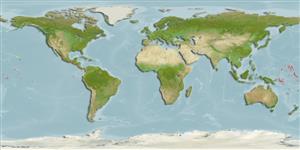Common names from other countries
>
Acanthuriformes (Surgeonfishes) >
Acanthuridae (Surgeonfishes, tangs, unicornfishes) > Acanthurinae
Etymology: Ctenochaetus: Greek, kteis, ktenos = comb + Greek, chaite = hair (Ref. 45335).
More on author: Valenciennes.
Environment: milieu / climate zone / depth range / distribution range
Écologie
marin récifal; profondeur 2 - 18 m (Ref. 42056), usually 9 - 12 m (Ref. 42056). Tropical; 15°N - 25°S, 150°E - 78°W
Pacific Ocean: Marshall, Caroline, Kiribati, Tuvalu, Johnston, Marquesas; including Clipperton Atoll, Cocos and Gorgona islands. Society and Line Islands (Ref. 37792).
Taille / Poids / Âge
Maturity: Lm ? range ? - ? cm
Max length : 27.0 cm TL mâle / non sexé; (Ref. 9710); poids max. publié: 410.75 g (Ref. 124696)
Épines dorsales (Total): 8; Rayons mous dorsaux (Total): 26-29; Épines anales 3; Rayons mous anaux: 24 - 26. Lower lip papillate posteriorly. Gill rakers on anterior row 26-29, on posterior row 34-37. Has brilliant blue spots covering the head, body, and pectoral fins and blue longitudinal pinstripes on the dorsal, anal and caudal fins (Ref 1602). Anterior dorsal soft rays longer than posterior (Ref 42056).
Inhabits shallow seaward reefs (Ref. 9710). Small schools may also be found in relatively turbulent waters of the surge zone (Ref. 9267). Benthopelagic (Ref. 58302). Feeds on film algae (Ref. 89972).
Life cycle and mating behavior
Maturité | Reproduction | Frai | Œufs | Fécondité | Larves
Randall, J.E and K.D. Clements, 2001. Second revision of the surgeonfish genus Ctenochaetus (Perciformes: Acanthuridae), with descriptions of two new species. Indo-Pac. Fish. (32):33 p. (Ref. 42056)
Statut dans la liste rouge de l'IUCN (Ref. 130435)
CITES (Ref. 128078)
Not Evaluated
Menace pour l'homme
Harmless
Utilisations par l'homme
Aquarium: Commercial
Plus d'informations
Noms communsSynonymesMétabolismePrédateursÉcotoxicologieReproductionMaturitéFraiFéconditéŒufsDéveloppement de l'œuf
RéférencesAquacultureProfil d'aquacultureSouchesGénétiqueElectrophoresesHéritabilitéPathologiesTraitementMass conversion
CollaborateursImagesStamps, Coins Misc.SonsCiguateraVitesseType de nageSurface branchialeOtolithesCerveauxVision
Outils
Articles particuliers
Télécharger en XML
Sources Internet
Estimates based on models
Preferred temperature (Ref.
115969): 25.5 - 29.4, mean 28.8 (based on 220 cells).
Phylogenetic diversity index (Ref.
82804): PD
50 = 0.5020 [Uniqueness, from 0.5 = low to 2.0 = high].
Bayesian length-weight: a=0.02344 (0.01098 - 0.05004), b=2.97 (2.80 - 3.14), in cm Total Length, based on LWR estimates for this (Sub)family-body shape (Ref.
93245).
Niveau trophique (Ref.
69278): 2.0 ±0.00 se; based on food items.
Résilience (Ref.
120179): Haut, temps minimum de doublement de population inférieur à 15 mois (Preliminary K or Fecundity.).
Fishing Vulnerability (Ref.
59153): Low vulnerability (17 of 100).
